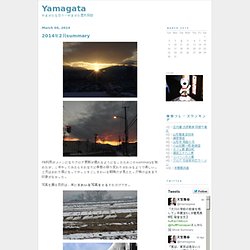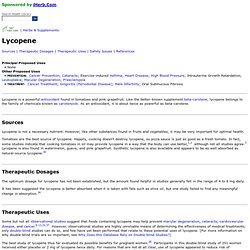

Masaharu Amagasa
Medical Doctor
Yamagata. FB利用がメインになりブログ更新が遅れるようになったためこのsummaryを始めたが、1年やってみたらそれなりに季節の移り変わりがわかるようで楽しい。

2月はおわり頃になってやっとすこしきれいな朝焼けが見えた。 夕焼けはあまり印象がなかった。 写真を撮る目的は、単にきれいな写真をとるそれだけです。 この冬は(まだ終わったわけではないが)雪は少なく、たいへん寒いというものであった。 冬の蔵王樹氷を晴れた日にいくという計画はことしもはたせず、月山が顔をだすくらい晴れた時にいかないといけない。 暖冬ではないのに雪が少なく、霞城公園の雪景色もなかなかであったが、山梨に豪雪がきたときに結構積もった。 冬場はなかなか月山は顔をださない。 World History. Japanese History. Welcome to the Center for Asian Studies. Fatty Acids. Anti-Aging. Functional Foods. Lycopene. | Herbs & Supplements: Sources | Therapeutic Dosages | Therapeutic Uses | Safety Issues | References Principal Proposed Uses • NoneOther Proposed Uses • PREVENTION:Cancer Prevention; Cataracts; Exercise-induced Asthma; Heart Disease; High Blood Pressure; Intrauterine Growth Retardation; Leukoplakia; Macular Degeneration; Preeclampsia • TREATMENT:Cancer Treatment; Gingivitis (Periodontal Disease); Male Infertility; Oral Submucous Fibrosis Lycopene is a powerful antioxidant found in tomatoes and pink grapefruit.

Like the better-known supplement beta-carotene, lycopene belongs to the family of chemicals known as carotenoids. As an antioxidant, it is about twice as powerful as beta-carotene. Sources Lycopene is not a necessary nutrient. Tomatoes are the best source of lycopene. Therapeutic Dosages The optimum dosage for lycopene has not been established, but the amount found helpful in studies generally fell in the range of 4 to 8 mg daily. Therapeutic Uses Safety Issues 1. 2. 3. 4. 5. 6. Health. Eating Food Rich In Omega-3 Fatty Acids Such As Fish, Chicken, and Nuts Lowers Risk of Alzheimer's Disease. Alzheimer's Disease is a condition where the normal and healthy functions of the human brain is damaged.

It is a form of dementia (a loss of brain function). Alzheimer's disease affects memory, thinking, cognition, and psychological behavior. It is incurable. The disease slowly progresses throughout the brain destroying brain cells. It is caused when protein fragments called plaques and tangles stick together to form the Alzheimer's protein. The disease usually affects the elderly but there are cases where people under the age of 65 contract Alzheimer's.
Eating fish, chicken, nuts may lower risk of Alzheimer's disease A new study suggests that eating foods that contain omega-3 fatty acids, such as fish, chicken, salad dressing and nuts, may be associated with lower blood levels of a protein related to Alzheimer's disease and memory problems. The study found that the more omega-3 fatty acids a person took in, the lower their blood beta-amyloid levels. Neurology. Alzheimer's information. Neurodegenerative Diseases. Lou Gehrig's Disease (Amyotrophic Lateral Sclerosis) Amyotrophic lateral sclerosis. Signs and symptoms[edit] The disorder causes muscle weakness and atrophy throughout the body due to the degeneration of the upper and lower motor neurons.

Unable to function, the muscles weaken and exhibit atrophy. Individuals affected by the disorder may ultimately lose the ability to initiate and control all voluntary movement, although bladder and bowel sphincters and the muscles responsible for eye movement are usually, but not always, spared until the final stages of the disease.[1] Cognitive function is generally spared for most patients, although some (about 5%) also have frontotemporal dementia.[2] A higher proportion of patients (30–50%) also have more subtle cognitive changes which may go unnoticed, but are revealed by detailed neuropsychological testing. Initial symptoms[edit] The earliest symptoms of ALS are typically obvious weakness and/or muscle atrophy.
About 25% of cases are "bulbar onset" ALS. Progression[edit] Late stage[edit] Cause(s)[edit] Genetics[edit] SOD1[edit] Neurosurgery. DigitalNeurosurgeon.com. Neuroscience. Neuroscience For Kids. The smell of a flower - The memory of a walk in the park - The pain of stepping on a nail.

These experiences are made possible by the 3 pounds of tissue in our heads...the BRAIN!! Neuroscience for Kids has been created for all students and teachers who would like to learn about the nervous system. Discover the exciting world of the brain, spinal cord, neurons and the senses. Use the experiments, activities and games to help you learn about the nervous system. There are plenty of links to other web sites for you to explore. Can't find what you are looking for? Portions of Neuroscience for Kids are available in Spanish, Slovene, Portuguese, Italian, Korean, Japanese, Serbian, Russian, Slovak, Romanian, Polish, Albanian, Czech, Finnish, Estonian, Hungarian, Punjabi, Indonesian, Malay, Norwegian, Ukranian and Turkish.
"Neuroscience for Kids" is maintained by Eric H. The Journal of Neuroscience. Society for Neuroscience. Explore the Brain and Mind - BrainFacts.org. JNS.